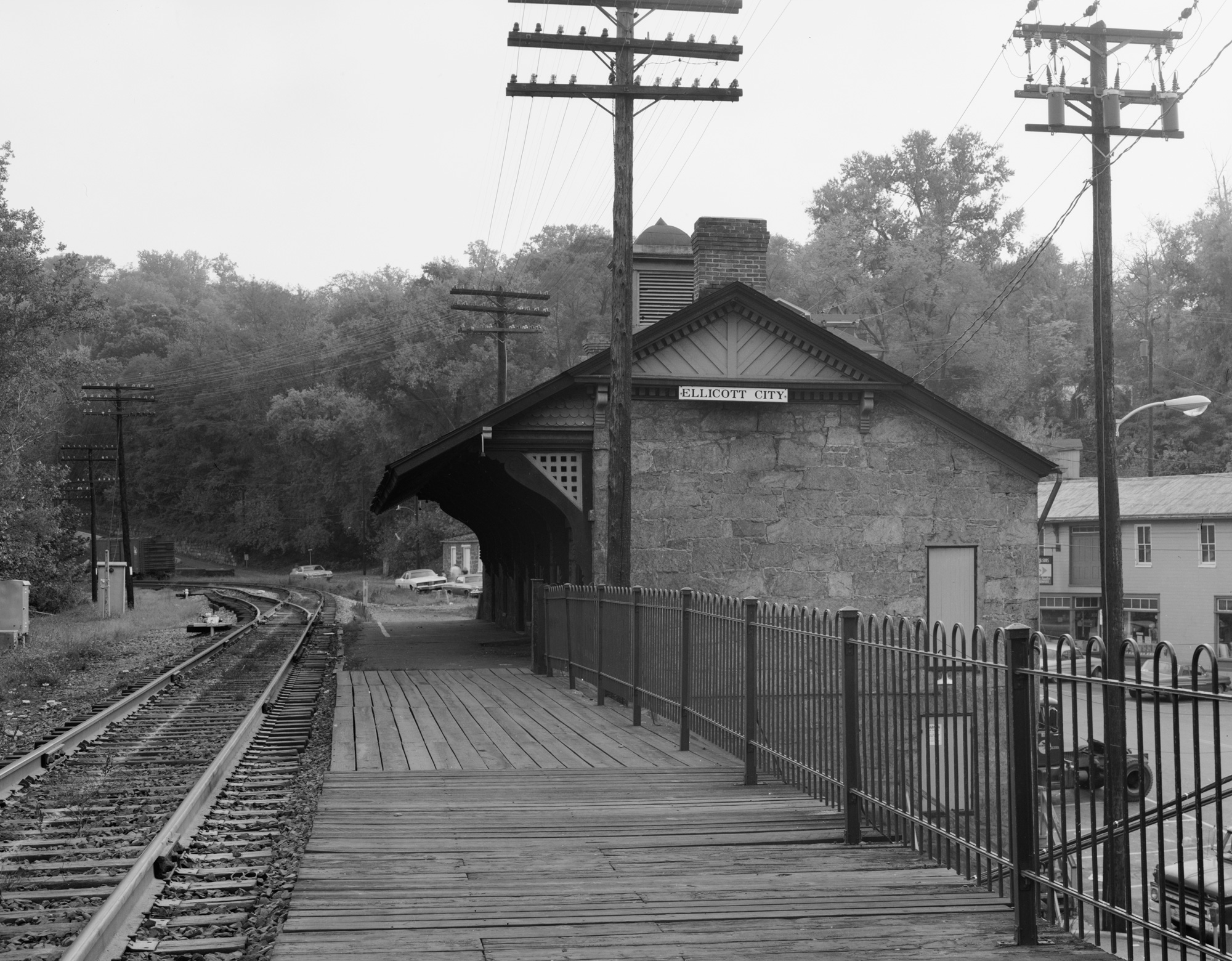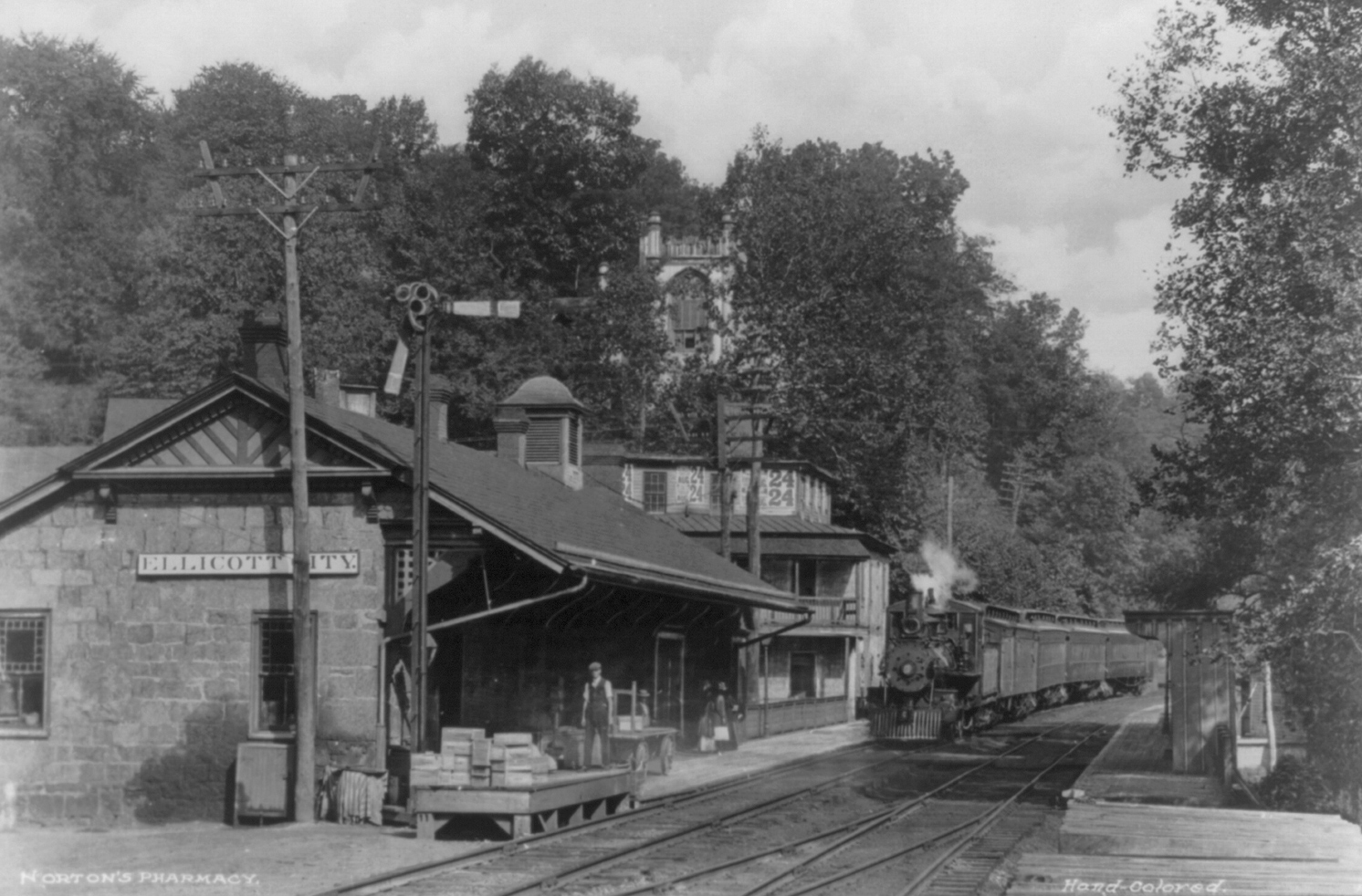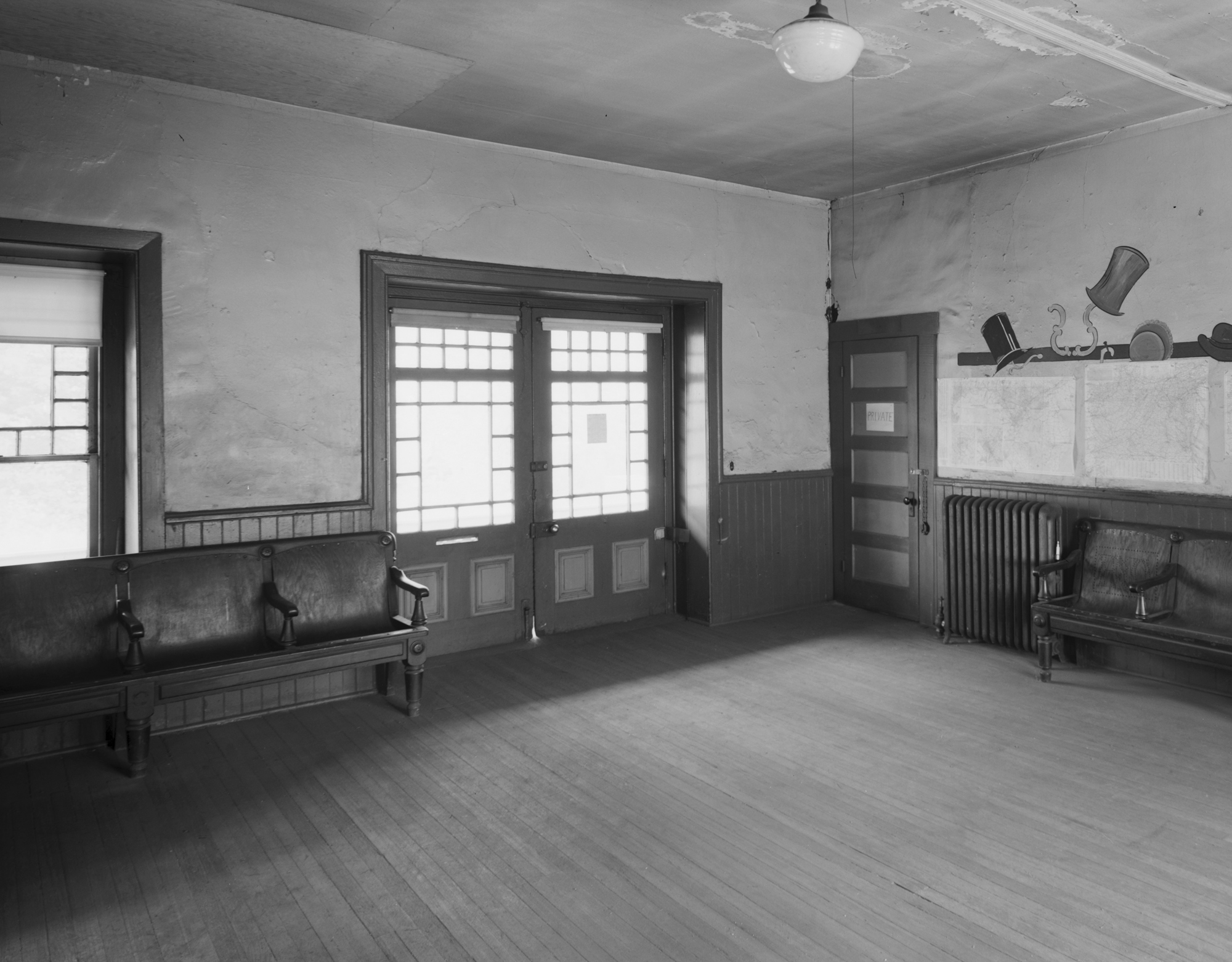Ellicott City Station (Maryland): History, Museum, Photos
Last revised: February 27, 2025
By: Adam Burns
When one views the Ellicott City station today there is nothing
particularly striking about it, when compared to other railroad depots
like it.
However, the station carries a significance far beyond its looks, as the building is our nation's oldest still-standing railroad depot, constructed by the Baltimore & Ohio Railroad.
What's more is that the depot's design would become the template for which most others like it would be constructed over the next century.
Aside from the building's architectural and historical significance, however, it did not offer much else for the B&O as the little community provided little online freight and passenger traffic.
Today the Ellicott City Station is a museum (part of the Baltimore & Ohio Railroad Museum) and owned by the town of Ellicott City, Maryland.
The Ellicott City Station, originally known as Ellicott's Mills Station, has an indelible link to the Baltimore & Ohio; it was not only the railroad's first depot but also the first hamlet it reached building west from Baltimore.
Three years after its charter the railroad had reached the then small community of Ellicott's Mills and initially did not even build a passenger station but a freight depot to serve the small industrial center located there.
The small depot also held significance as the original main line of the B&O (despite a later alignment trumping the route through Ellicott's Mills it is still in use today, known as the "Old Main Line).
In the early years, Ellicott City Station did hold a bit of importance to the B&O. Before the railroad began its march westward the depot served as a western terminus for the B&O where its small fleet of steam locomotives was serviced and turned for the 13-mil trip back to Baltimore.
Early on the location did not have a turntable although one was later installed during the Civil War in 1863. Additionally, the depot was actually a two-story building with only the second-floor at track level.
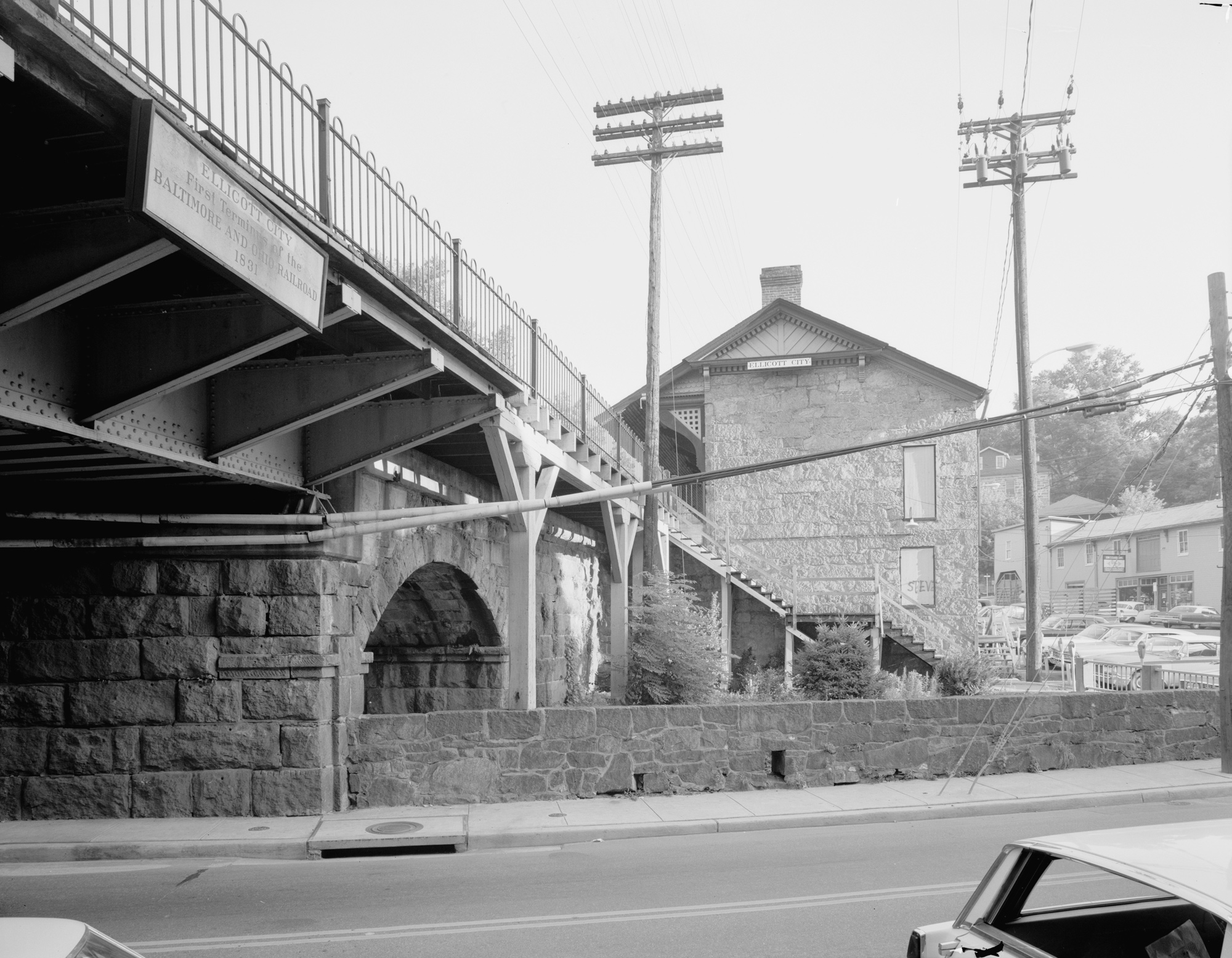 Ellicott City Station circa 1970. Note the sign: "Ellicott City Station, First Terminus Of The Baltimore And Ohio Railroad, 1831." William Barrett photo.
Ellicott City Station circa 1970. Note the sign: "Ellicott City Station, First Terminus Of The Baltimore And Ohio Railroad, 1831." William Barrett photo.The railroad came to realize that, at least for a time, Ellicott's Mills would be the western edge of its system and as such constructed the Oliver Viaduct directly on approach to the depot.
This ingenious little idea allowed crews to service the steam locomotives from below, essentially making it an early service pit now common in modern railroad maintenance facilities.
Overall, the depot featured a simple gabled roof with a small central cupola. The overhang it featured covering the boardwalk is what really set it apart and was a design that most future small depots would use, allowing passengers to remain dry even while outside in poor weather.
The depot's freight importance was mostly during its early years when a local granite quarry, known as Ellicott's quarries, supplied the B&O with a substantial amount of tonnage while in use (the granite also helped build the depot as well as the later turntable).
Aside from the quarry service, the B&O only saw freight from nearby farms and locals. Overall, however, as for Ellicott City Station itself its importance would never really transcend further than its significance as our country's oldest railroad depot (which was originally built in 1830).
Ellicott City's magnitude for the railroad, at least in terms of a passenger hub, would quickly dwindle following the 20th century and by 1949 trains stopped serving the depot altogether.
By the early 1970s the B&O itself, by then part of the Chessie System (the C&O, B&O, and WM united under one flag), would discontinue use at the station. Fortunately, however, the building's future had already been secured when a few years prior to that in the late 1960s it was placed on the National Register of Historic Places.
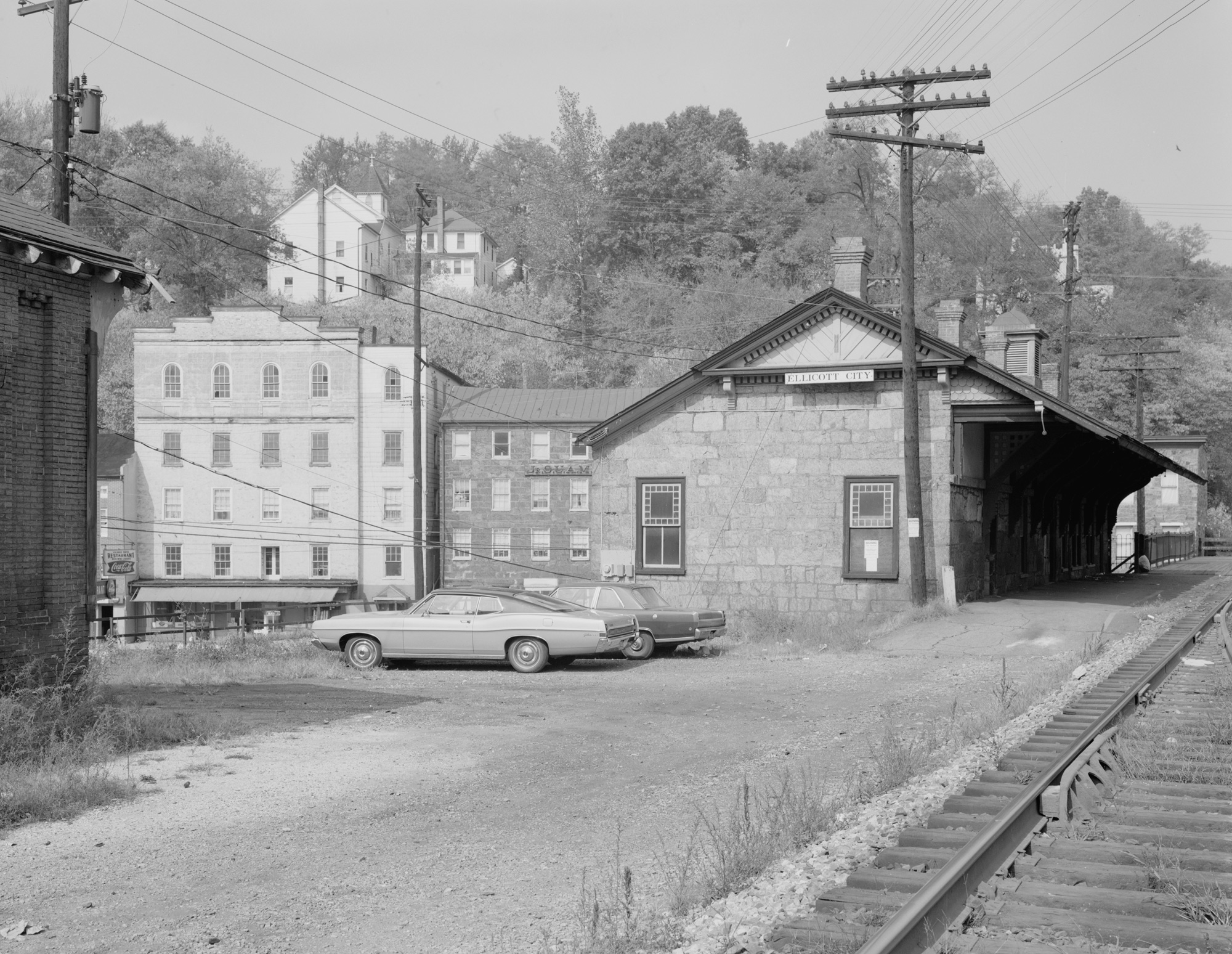 Ellicott City Depot circa 1970. Directly where the vehicles are parked is the location of an original turntable, buried but completely intact. It has since been unearthed and can now be viewed. William Barrett photo.
Ellicott City Depot circa 1970. Directly where the vehicles are parked is the location of an original turntable, buried but completely intact. It has since been unearthed and can now be viewed. William Barrett photo.It would take, however, until the mid-1990s before the town would gain ownership of the station when at that time CSX Transportation, the successor to the B&O and Chessie System, deeded the building over to Ellicott City.
Today, the Ellicott City Station is part of the Baltimore & Ohio Railroad Museum and known as the Ellicott City Baltimore & Ohio Railroad Museum.
Along with touring
the building, learning about its history, and seeing the items on
display the museum also houses a large model layout and has a number of
events and programs ongoing throughout the year to take advantage of.
Recent Articles
-
Maryland's - Wine Tasting - Train Rides
Jan 15, 26 02:59 PM
This article delves into the enchanting world of wine tasting train experiences in Maryland, providing a detailed exploration of their offerings, history, and allure. -
Colorado's - Wine Tasting - Train Rides
Jan 15, 26 02:46 PM
To truly savor these local flavors while soaking in the scenic beauty of Colorado, the concept of wine tasting trains has emerged, offering both locals and tourists a luxurious and immersive indulgenc… -
Iowa ~ Wine Tasting ~ Train Rides
Jan 15, 26 02:36 PM
The state not only boasts a burgeoning wine industry but also offers unique experiences such as wine by rail aboard the Boone & Scenic Valley Railroad. -
Georgia's Wine Train Rides In Cordele!
Jan 15, 26 02:26 PM
While the railroad offers a range of themed trips throughout the year, one of its most crowd-pleasing special events is the Wine & Cheese Train—a short, scenic round trip designed to feel like a t… -
Indiana ~ Murder Mystery ~ Dinner Train Rides
Jan 15, 26 02:22 PM
This piece explores the allure of murder mystery trains and why they are becoming a must-try experience for enthusiasts and casual travelers alike. -
Ohio ~ Murder Mystery ~ Dinner Train Rides
Jan 15, 26 02:10 PM
The murder mystery dinner train rides in Ohio provide an immersive experience that combines fine dining, an engaging narrative, and the beauty of Ohio's landscapes. -
Nevada Dinner Train Rides In Ely!
Jan 15, 26 02:01 PM
If you’ve ever wished you could step through a time portal into the hard-working world of a 1900s short line the Nevada Northern Railway in Ely is about as close as it gets. -
Michigan Dinner Train Rides In Owosso!
Jan 15, 26 09:46 AM
The Steam Railroading Institute is best known as the home of Pere Marquette #1225 and even occasionally hosts a dinner train! -
Arizona's - Wine Tasting - Train Rides
Jan 14, 26 02:04 PM
For those who want to experience the charm of Arizona's wine scene while embracing the romance of rail travel, wine tasting train rides offer a memorable journey through the state's picturesque landsc… -
Arkansas's - Wine Tasting - Train Rides
Jan 14, 26 01:57 PM
This article takes you through the experience of wine tasting train rides in Arkansas, highlighting their offerings, routes, and the delightful blend of history, scenery, and flavor that makes them so… -
Tennessee ~ Murder Mystery ~ Dinner Train Rides
Jan 14, 26 01:42 PM
Amidst the rolling hills and scenic landscapes of Tennessee, an exhilarating and interactive experience awaits those with a taste for mystery and intrigue. -
California ~ Murder Mystery ~ Dinner Train Rides
Jan 14, 26 01:26 PM
When it comes to experiencing the allure of crime-solving sprinkled with delicious dining, California's murder mystery dinner train rides have carved a niche for themselves among both locals and touri… -
Illinois ~ Murder Mystery ~ Dinner Train Rides
Jan 14, 26 01:13 PM
Among Illinois's scenic train rides, one of the most unique and captivating experiences is the murder mystery excursion. -
Vermont's - Murder Mystery - Dinner Train Rides
Jan 14, 26 12:57 PM
There are currently murder mystery dinner trains offered in Vermont but until recently the Champlain Valley Dinner Train offered such a trip! -
Massachusetts Dinner Train Rides On Cape Cod!
Jan 14, 26 12:20 PM
The Cape Cod Central Railroad (CCCR) has carved out a special niche by pairing classic New England scenery with old-school hospitality, including some of the best-known dining train experiences in the… -
Maine Dinner Train Rides In Portland!
Jan 14, 26 11:31 AM
While this isn’t generally a “dinner train” railroad in the traditional sense—no multi-course meal served en route—Maine Narrow Gauge does offer several popular ride experiences where food and drink a… -
Kentucky Dinner Train Rides In Bardstown!
Jan 13, 26 01:14 PM
The essence of My Old Kentucky Dinner Train is part restaurant, part scenic excursion, and part living piece of Kentucky rail history. -
Kansas Dinner Train Rides In Abilene!
Jan 13, 26 12:44 PM
If you’re looking for a heritage railroad that feels authentically Kansas—equal parts prairie scenery, small-town history, and hands-on railroading—the Abilene & Smoky Valley Railroad (A&SV) delivers. -
Michigan ~ Murder Mystery ~ Dinner Train Rides
Jan 13, 26 11:24 AM
Among the lesser-known treasures of this state are the intriguing murder mystery dinner train rides—a perfect blend of suspense, dining, and scenic exploration. -
Virginia's - Murder Mystery - Dinner Train Rides
Jan 13, 26 11:11 AM
Among the state's railroad attractions, murder mystery dinner trains stand out as a captivating fusion of theatrical entertainment, fine dining, and scenic travel. -
Arizona Dinner Train Rides At The Grand Canyon!
Jan 13, 26 10:59 AM
While the Grand Canyon Railway does not offer a true, onboard dinner train experience it does offer several upscale options and off-train dining. -
Georgia Dinner Train Rides In Nashville!
Jan 13, 26 10:27 AM
If you’ve ever wished you could slow down, trade traffic for jointed rail, and let a small-town landscape roll by your window while a hot meal is served at your table, the Azalea Sprinter delivers tha… -
Indiana Valentine's Train Rides
Jan 12, 26 04:27 PM
If you’ve ever wished you could step into a time when passenger trains were a Saturday-night treat and a whistle echoing across farm fields meant “adventure,” the Nickel Plate Express delivers that fe… -
Ohio Valentine's Train Rides!
Jan 12, 26 04:20 PM
The Hocking Valley Scenic Railway offers one of the region’s most atmospheric ways to experience the Hocking Hills area: from the rhythmic click of jointed rail to the glow of vintage coaches rolling… -
Wisconsin's - Wine Tasting - Train Rides
Jan 12, 26 03:10 PM
Wisconsin might not be the first state that comes to mind when one thinks of wine, but this scenic region is increasingly gaining recognition for its unique offerings in viticulture. -
California's - Wine Tasting - Train Rides
Jan 12, 26 02:34 PM
This article explores the charm, routes, and offerings of these unique wine tasting trains that traverse California’s picturesque landscapes. -
Wisconsin Scenic Train Rides In North Freedom!
Jan 12, 26 02:20 PM
The Mid-Continent Railway Museum is a living-history museum built around the sights, sounds, and everyday rhythms of small-town and shortline railroading in the early 20th century, what the museum cal… -
Vermont Scenic Train Rides In Burlington!
Jan 12, 26 01:18 PM
Today, GMRC is best known by many travelers for its Burlington-based passenger experiences—most famously the Champlain Valley Dinner Train and the sleek, limited-capacity Cocktails on the Rails. -
Maryland's - Murder Mystery - Dinner Train Rides
Jan 12, 26 01:03 PM
Maryland is known for its scenic landscapes, historical landmarks, and vibrant culture, but did you know that it’s also home to some of the most thrilling murder mystery dinner trains? -
Minnesota's - Murder Mystery - Dinner Train Rides
Jan 12, 26 12:17 PM
Murder mystery dinner trains offer an enticing blend of suspense, culinary delight, and perpetual motion, where passengers become both detectives and dining companions on an unforgettable journey. -
Vermont Dinner Train Rides In Burlington!
Jan 12, 26 12:09 PM
There is one location in Vermont hosting a dedicated dinner train experience at the Green Mountain Railroad. -
Connecticut Dinner Train Rides In Essex!
Jan 12, 26 10:39 AM
Connecticut's rail heritage can be traced back to the industry's earliest days and a few organizations preserve this rich history by offering train rides. The Essex Steam Train also hosts dinner-theme… -
Florida Scenic Train Rides In Parrish!
Jan 11, 26 10:26 PM
The Florida Railroad Museum (FRRM) in Parrish offers something increasingly rare in today’s rail landscape: a chance to ride historic equipment over a surviving fragment of an early-20th-century mainl… -
California's - Wine Tasting - Train Rides
Jan 11, 26 02:28 PM
This article explores the charm, routes, and offerings of these unique wine tasting trains that traverse California’s picturesque landscapes. -
Georgia's - Murder Mystery - Dinner Train Rides
Jan 11, 26 02:07 PM
In the heart of the Peach State, a unique form of entertainment combines the thrill of a murder mystery with the charm of a historic train ride. -
Colorado ~ Murder Mystery ~ Dinner Train Rides
Jan 11, 26 01:43 PM
Nestled among the breathtaking vistas and rugged terrains of Colorado lies a unique fusion of theater, gastronomy, and travel—a murder mystery dinner train ride. -
Minnesota Dinner Train Rides In Duluth!
Jan 11, 26 01:32 PM
One of the best ways to feel the region's history in motion today is aboard the North Shore Scenic Railroad (NSSR), which operates out of Duluth’s historic depot. -
Illinois Dinner Train Rides At Monticello!
Jan 11, 26 12:42 PM
The Monticello Railway Museum (MRM) is one of those places that quietly does a lot: it preserves a sizable collection, maintains its own operating railroad, and—most importantly for visitors—puts hist… -
Alabama's - Wine Tasting - Train Rides
Jan 10, 26 09:29 AM
While the state might not be the first to come to mind when one thinks of wine or train travel, the unique concept of wine tasting trains adds a refreshing twist to the Alabama tourism scene. -
Maryland Dinner Train Rides At WMSR!
Jan 10, 26 09:13 AM
The Western Maryland Scenic Railroad (WMSR) has become one of the Mid-Atlantic’s signature heritage operations—equal parts mountain railroad, living museum, and “special-occasion” night out. -
Arkansas Dinner Train Rides On The A&M!
Jan 10, 26 09:11 AM
If you want a railroad experience that feels equal parts “working short line” and “time machine,” the Arkansas & Missouri Railroad (A&M) delivers in a way few modern operations can. -
South Dakota's - Murder Mystery - Dinner Train Rides
Jan 10, 26 09:08 AM
While the state currently does not offer any murder mystery dinner train rides, the popular "1880 Train" at the Black Hills Central recently hosted these popular trips! -
Wisconsin's - Murder Mystery - Dinner Train Rides
Jan 10, 26 09:07 AM
Whether you're a fan of mystery novels or simply relish a night of theatrical entertainment, Wisconsin's murder mystery dinner trains promise an unforgettable adventure. -
Missouri's - Murder Mystery - Dinner Train Rides
Jan 10, 26 09:05 AM
Missouri, with its rich history and scenic landscapes, is home to one location hosting these unique excursion experiences. -
Washington ~ Murder Mystery ~ Dinner Train Rides
Jan 10, 26 09:04 AM
This article delves into what makes murder mystery dinner train rides in Washington State such a captivating experience. -
Kentucky Scenic Train Rides At KRM!
Jan 09, 26 11:13 PM
Located in the small town of New Haven the Kentucky Railway Museum offers a combination of historic equipment and popular excursions. -
Washington "Wine Tasting" Train Rides
Jan 09, 26 08:53 PM
Here’s a detailed look at where and how to ride, what to expect, and practical tips to make the most of wine tasting by rail in Washington. -
Kentucky's - Wine Tasting - Train Rides
Jan 09, 26 08:21 PM
Kentucky, often celebrated for its rolling pastures, thoroughbred horses, and bourbon legacy, has been cultivating another gem in its storied landscapes; enjoying wine by rail. -
Kentucky's - Murder Mystery - Dinner Train Rides
Jan 09, 26 01:12 PM
In the realm of unique travel experiences, Kentucky offers an enchanting twist that entices both locals and tourists alike: murder mystery dinner train rides. -
Utah's - Murder Mystery - Dinner Train Rides
Jan 09, 26 01:05 PM
This article highlights the murder mystery dinner trains currently avaliable in the state of Utah!

